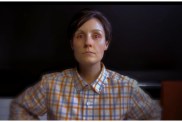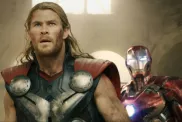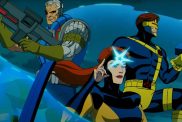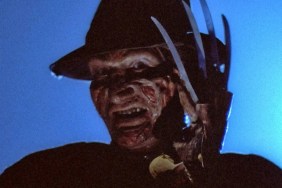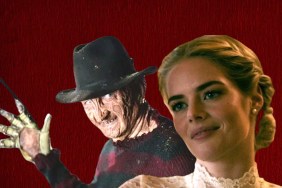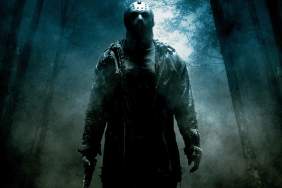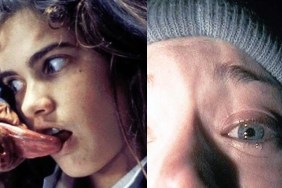Platinum Dunes on its latest franchise reboot

Concern envelopes a mother’s face as she embraces her five-year-old daughter. The girl is calm. Confused, perhaps. Something is wrong. And it’s apparent why when her mother lifts the back of her shirt and reveals any parent’s greatest fear. Her daughter has been abused. The marks on her back indicate she’s been raked by a set of claws. Mom runs her fingers delicately over the spot before a tattooed, blue jeans and tank top-wearing Sam Bayer calls out “Cut!” from his director’s chair parting the unsettling silence that creeps over the set like a black miasma.
The scene Bayer is trying to put to film is uncomfortable. A child in peril is no laughing matter and the tone of this set tonight is undeniably an intense one. Compounding matters, Bayer and Platinum Dunes’ Andrew Form and Brad Fuller are trying to get “the reveal” just right while keeping the young girl focused. The producing pair are uncharacteristically grave. There’s nothing lofty about their demeanor, especially in the wake of a successful weekend on Friday the 13th. Frustration reads on their faces. This shot needs to get done so they can move to the next set-up. Both leave their spot at video village to assist Bayer (consistent with the duo’s hands-on approach in all of their productions).
The director calls for another take. Those claw marks are revealed again, hammering home the obvious during Shock’s first 30 minutes on the Chicago set of A Nightmare on Elm Street: Freddy’s back.
The Nightmare Reborn
A reboot of Wes Craven’s 1984 film – which introduced the world to the heavily scarred dream-hopping killer Freddy Krueger – traveled a far less bumpy road than New Line Cinema’s last Krueger outing, Freddy vs. Jason. The studio, briefly, toyed with a sequel to that long-awaited mano-a-mano showdown after its 2003 release, however, it reconsidered this maneuver when Platinum Dunes – Michael Bay’s genre production outfit – later pursued the notion of giving the franchise an overhaul as it had done for The Texas Chainsaw Massacre and Friday the 13th.
“New Line thinks that this is like their Batman and Freddy Kruger is very important to them,” Fuller explains, reconnecting with Shock as the film crew relocates to another section of the soundstage. Until now, principal photography has all been on location. “We were trying to get these rights before Friday the 13th and feet were dragging for a long time.” The departure of New Line head Robert Shaye had much to do with this. Shaye opted to bid adieu to the house that Krueger built when New Line was absorbed into Warner Bros. “The brakes came out and there really wasn’t anything to do on this for about six months. It really wasn’t until Friday the 13th was done and in the can that they felt positive about it and they finally decided, ‘Yeah, let’s go with these guys.’ There are probably 10 or 15 other horror producers, or competent producers, who would have died to make this movie. It was not a rights issue as much as ‘Whose hands are we going to put this in?’ And we had to prove to them that we were the best guys for the job.”
Warner Bros. commissioned Wesley Strick (Cape Fear, Wolf) to pen a script that would take elements of Craven’s original film and re-introduce them to a new audience. Strangely, when Platinum Dunes entered the picture, they were informed Craven was going to have nothing to do with the reboot. “I don’t know if New Line went to him and they couldn’t come to an agreement,” Fuller says. “I don’t know what happened there. I can certainly empathize with the fact that he created it and has nothing to do with it and that’s not something that we feel good about. As producers and horror fans, Wes Craven is one of our heroes in the respect that he’s made movies that we all love and love to make movies that are similar to those. Sometimes it works great in these situations. We had a great relationship with Sean Cunningham and that was great. With Wes we never had an opportunity to have that, I’ve never talked to him on the phone.”

With Strick’s script in hand, Fuller and Form turned to writer Eric Heisserer (The Thing prequel) to do a rewrite.
“This one’s more like [Texas Chainsaw Massacre],” Form tells us when pressed for more details on whether the film is a straight-up remake or not. “It’s not Friday the 13th where we picked through a whole bunch of movies. I think this one holds truer to the original Nightmare.”
Fuller adds: “We went off of the same general story and made some changes to it. This is not going to be ‘The Best of Nightmare on Elm Street.'”
Nightmare eschewed the sex, drugs and rock ‘n roll mentality of Friday the 13th in lieu of a darker flavor that Fuller and Form liken to Chainsaw, but in a different way. Fuller references the scene this writer watched earlier tonight as an example and hints the film deals with “horrible” themes. Hardly how the first Krueger franchise ended. Fans watched him, in his later years, wise-crack his way through a battle with his daughter (Freddy’s Dead), take the meta-film approach in New Nightmare and duke it out with Jason Voorhees. Dark and horrible themes were apparent in spurts. New Line agreed with Platinum Dunes that a tonal overhaul was needed.
“I don’t think that anyone saw this characterized as a fun horror movie,” Fuller asserts. “I would characterize Friday the 13th as a fun horror movie and when we make another one of those that’s what we’re going for that. With this, it’s more about terrifying and unsettling and, if we’re lucky, making people have horrible nightmares. I mean that’s what the whole movie’s about and that’s what we’re aiming to do.”
Entering the Dreamscape
I open my eyes and I’m in a classroom. Fire safety is the lesson of the day and this place is proof of why you should never play with matches. The desks are torched, their surfaces flakey. Same goes for the walls which now takes on the color of charcoal. There’s little to salvage from the collection of books lining the shelves. On the chalk board are playful drawings. The smell here is different. Not like other areas of the soundstage. It actually has the aroma of a scorched building.
This is just one of the many Nightmare sets that are going to be used for the dream sequences inhabited by Kruger. It’s joined by a second classroom set right next door. Here it’s a bit cleaner, but still awash in cinder.
“I think our dreams are much closer to the first film than anything else,” says Fuller, taking us on a guided tour. “These setsâ¦they’re dark and they’re dreary and there’s not a sense of wonder or fun in any way shape or form. That’s not the movie Sam wanted to tell, that’s not what we wanted and that’s not what New Line was looking for. So, these nightmares are truly nightmares and that’s one of the things that Sam is so great about. We all have nightmares but it’s a difficult thing to communicate what they feel like and I think that that’s what Sam is really doing an amazing job with is when I’m watching it, I’ve had nightmares that feel this horrible, and he’s bringing that to film, which is a really hard thing to do.”
Bayer’s relationship with Platinum Dunes has been a long one, even though they had never worked together. When Fuller and Form produced 2005’s The Amityville Horror, Bayer – a respected music video director (Nirvana’s “Smells Like Teen Spirit”) and graduate of New York’s School of Visual Arts – was going to make his feature debut with the remake. Andrew Douglas ultimately wound up directing, however, and Platinum Dunes attached Bayer to an abandoned remake of Near Dark.
Fuller says, “We try to hire very visual directors to make our films and make them look a certain way. And the dreams have always been very enticing to us because certainly with a visual director you put that in the heads of someone who can do something amazing visually, it heightens what that movie is. For us it was always about finding the right guy who can make those dreams just feel amazing and visually more than anything anyone had seen in the original film.”

Finding the right guy nearly became more difficult than Platinum Dunes anticipated. Bayer passed twice on the chance to do Nightmare. But Platinum Dunes, especially Michael Bay, wasn’t going to take no for an answer. The director behind Armageddon and the Transformer films reached out to Bayer himself when Fuller and Form reported back with the disappointing news of Bayer’s refusal. “They had a conversation or some kind of exchange where I think Michael made a very intelligent reason for Sam to do this movie and get behind it,” Fuller recounts. “Literally, as soon as that happened, Sam got on board and it comes back to the fact that his work is visually astonishing and it’s varied. He has a handle on the technical aspects of making these dreams work and he cares a tremendous amount about performance.”
“A true artist,” continues Form. “He’s a painter, a photographer. He does it all. We have a map in this movie that is the ‘Nightmare Mapâ that’s created, Sam was out there painting on it. It’s pretty amazing stuff that he brings to this film.”
A taste of the film’s own divergent artistry is demonstrated in our shift from the classrooms to a cave setting. Fuller offers us no intro and the publicist remains mum on its relevancy to the plot. A skeletal frame of wood and metal greets us, but within it’s all faux rock and candles clumped together on ridges and on the cave floor. A soiled teddy bear peers lifelessly from a nearby puddle, head turned upwards at the countless tendrils snaking out the ceiling. At the far end is a brick wall, a telling sign this isn’t just “a cave” after all. Is this Krueger’s new domain? Has he put the ol’ boiler room on the real estate block? Or is this merely another landscape of one of his victim’s nightmares?
One, Two, Freddy’s Comin’ for Youâ¦
Shock is in the final leg of our tour and this writer has reunited with the crew who are now huddled around a 20-foot underground tunnel that Cassidy is about to enter. The tunnel has been severed in half, like a worm bisected length-wise, so the camera can give a viewer the impression that it is tracking along its span as Cassidy crawls inside – tight quarters for this Melrose Place star who has already accrued a horror resume that includes When a Stranger Calls, Black Christmas (both remakes), Supernatural and Harper’s Island. She co-stars in Nightmare with Rooney Mara, the new âNancy Thompson,â Kyle Gallner and Thomas Dekker.
Something’s familiar about what Cassidy is wearing (which isn’t much). Below those blonde locks and face that graced Abercrombie & Fitch modeling photos early in her career, the actress is wearing a football tee, sleeves striped, with the number 10 on the chest – the same style of shirt worn by Johnny Depp in the original Nightmare. Of course, he didn’t look nearly as good and wasn’t in tight blue shorts with white flowers on them.
As of late, there has been Internet speculation as to how Nancy Thompson, and her friends, have changed between the original film and the update. Fuller assures us any rumors that Thompson is “goth,” are just that: Rumors. Cassidy plays “Kris,” the Tina character formerly essayed by Amanda Wyss. “Nancy has a similar arc [she had in the original],” Fuller assures us. “Kris has a lot more to do than Tina did.”
Cassidy is asked to climb into the tunnel. Overhead crew members ready bags of Fuller’s earth that will be sifted through the top of the tunnel and onto the actress as she crawls through. Bayer, seated about ten feet away, pulls his iPod headphones away from his ears, and calls for “action.â Cassidy begins her trek. From what this writer gathers, she’s chasing after a little girl.
“Hey wait! Where are you going?” she calls out.
Off camera, Bayer feigns the cry of a little girl (which will, of course, be added in post-production) and Cassidy responds, quickening her pace. After a few takes, Bayer is satisfied.
It’s time for Freddy Krueger to make his appearance.
The Man of Your Dreams
Haley appears on set in full Krueger make-up. He’s outfitted with his hat and glove, ready to work.
The scene calls for Cassidy to be positioned at one end of the tunnel. As she continues to crawl through, Krueger makes his introduction in the opposite end and starts off after her like a spider approaching a fly. Fuller’s earth drops all around Cassidy and the tunnel’s stability is called into question. The two make a go of it until, in the first take, Haley loses his hat when it rubs along the ceiling of the tunnel. The cramped space, even for Haley, is a challenge. Take two. Haley gives it another effort and succeeds. The hat stays on and he preserves the high creep factor of the sequence.
Better yet, Krueger says nothing. No witty quip at all.

“He wasn’t that way in the first couple [of films] and that’s what we’re sticking to,” Fuller says proudly. “We’ve never been attracted to the jokey antagonist because it feels less scary and less real. Freddy looks very different. He looks like a real burn victim and that’s what’s important to us. And he’s not witty. He’s a f**ked up guy.”
No kidding. Andrew Clement’s make-up is one of Krueger’s various ever-changing guises throughout the franchise. Even though Wes Craven re-introduced his killer in a radically different form in New Nightmare, this reboot’s take on the make-up has divided the franchise’s most loyal fans already. Clement, who most recently worked on J.J. Abram’s Star Trek, is working alongside Bart Mixon, his key guy on this production. Mixon is a Nightmare vet himself having worked on Nightmare on Elm Street 2 and Nightmare on Elm Street 4.
“We spent months in the design phase here,” says Clement. “There were three of us doing all of these designs and we just went through all of these iterations. Sam sat with us and we went through books trying to figure out what it was going to be. I have a hard drive full of hundreds of iterations. As we’re finalizing the sculpture, the design is still changing. I came in with a really open mind. I didn’t know if someone was going to ask me to do a portrait, I didn’t know if somebody was going to ask me to do the same old stuff. When we really started to seriously talk about it, one thing everybody really wanted to step away from was the whole stretchy skin all over the place, which just thrilled me. There’s so much more opportunity for this, I’m just really happy.”
At the start, Haley’s make-up would take six hours to apply. Now, Clement says he’s whittled down the process to just over three hours. Form adds there was a line they did not want to cross with the realistic approach to Krueger’s visage.
“We had reference photos that we were going off of and you start with a bunch of pictures about how far you want to go,” he explains. “Even with the skin color of a burn victim, how white the face looks or the pigmentation you have in it. There was definitely too far where I don’t think you would even look at Freddy. You would turn away when he came on the screen. So you dial it back, do some tests.”
“It’s just so grizzly, it’s hard to look at. And it still is,” Fuller continues. “It’s just little things we tried to do. We wanted to make it so you could see Jackie’s eyes a little bit better. I think some of the earlier versions had the skin so burnt you could really see his eyes and see him emoting. We did some work with that.”
From the sound of it, finding a new Krueger was an easier process than locking down what he’d look like. Because Robert Englund’s return was never even discussed, the Platinum Dunes team was free to pick anyone new, and they had one man in mind.
“Even before Sam was involved, Jackie was always the guy we wanted to play Freddy,” confesses Fuller. “I think that New Line knew it also. I think that they wanted him. As soon as we got the job we said this is the guy that we want. In our mind it’s not like: Jackie was in first place and these two other guys [are] in second and third. It was Jackie or there’s no movie in our mind. And New Line ultimately felt the same way.”

Another tough decision that need to be made was the nature of Freddy Krueger’s origins. Rumors stated that, in this incarnation, Krueger was wrongly convicted, making him sympathetic in some respects. Fuller addresses this speculation the best way he can: “We’re starting over from the very beginning and I think that when parents are confronted with the notion that their child might or might not have been molested, that’s an interesting part of the story for us. As you saw in the scene [earlier tonight], a kid can’t really say yes or no and how is it happening. Our Freddy is definitely, and I don’t think I’m letting the cat out of the bag, not a child killer. He probably has killed, but that’s not our angle. Our angle is more of the molestation. And that makes it different and more horrifying I think.”
Just a Dream?
This writer’s set visit is coming to an end. It’s well past midnight and a crew member greets Shock with a pelican case and I’m immediately struck with a case of déjà vu. This is how they introduced Jason Voorhees’ mask when I ventured to Texas for Friday the 13th. The case is opened and there it is: Krueger’s glove. Not all that dissimilar from the original except for the metacarpal bone-like strips of metal that lay over the top of the hand.
I’m allowed to wear the glove. Itâs a tough fit but I get a sense of its weight and the type of coordination one would need to wield this weapon. Pinch me because I must be dreaming, I think. Never in my life did this Krueger fan think he’d get to try on a screen-used glove!
Glove designs of all types and sizes are then presented. These were all of the discarded ideas: Gloves with short knives, long knives. Gloves that look as if they were designed by Tim Burton and carry various and wild sharp tools on each finger. Luckily, the production was wise to take the “if it ain’t broke, don’t fix it approach.”
Undoubtedly, Platinum Dunes is going to great lengths to make sure they knock it out of the park with A Nightmare on Elm Street, a risky endeavor that once again puts the company in the horror hot seat. Will they succeed as Robert Shaye, and his then fledgling company New Line, had over 20 years ago and re-launch one of horror’s most profitable franchises? That answer comes on April 30.
For more from Shock’s set visit, check out our spotlight on Jackie Earle Haley right here!





Source: Ryan Rotten, Managing Editor


